Design is more than a creative process at Culp Home Fashions — it’s a collaborative affair.
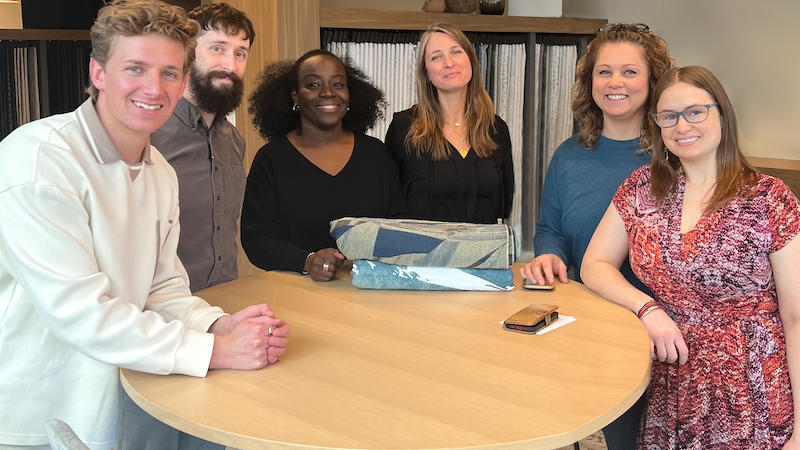
It’s 10:30 a.m. on Thursday, and Christina Pennant, director of design and merchandising for Culp Home Fashions, meets us at the Culp Innovation Center at Cong-don Yards in downtown High Point, North Carolina — and she’s not alone. She has a half dozen bright designers in tow.
The space itself, inside a former hosiery mill, inspires design: Raw brick and wood meld with contemporary glass walls that allow natural daylight to illuminate the fabric. Add a neutral palette and the effect could be described as a canvas for Culp’s culture while remaining modern and timeless.
The designers compare the sweeping space to “a dining room” where they serve their products to clients, but they are just as happy being hard at work at their craft “in the kitchen,” or the Culp factory in Stokesdale, North Carolina. And they’re also quite mellow coming off a busy week unveiling new collections at ISPA EXPO (see page 48).
Still, they’re amenable to sharing each other’s strengths and what makes Culp Home Fashions different from other ticking manufacturers.
Designer handwriting
Mattress fabric design is like a form of abstract art. Part of Pennant’s job is inspiring her team of designers.
“I lean into the designer’s strengths, and it goes back to their handwriting (their own individual design style),” Pennant says. “Each one on my team brings a different attribute. So, I lean into that for inspiration. If I know that, as a designer, you lend yourself more to performance or flows or shimmer, in terms of how you work with tacking colors, I will leverage that. I will also leverage the skills of your background in terms of where you’ve been and what you’re aspiring to do. And I’ll help you grow as much as I possibly can.”
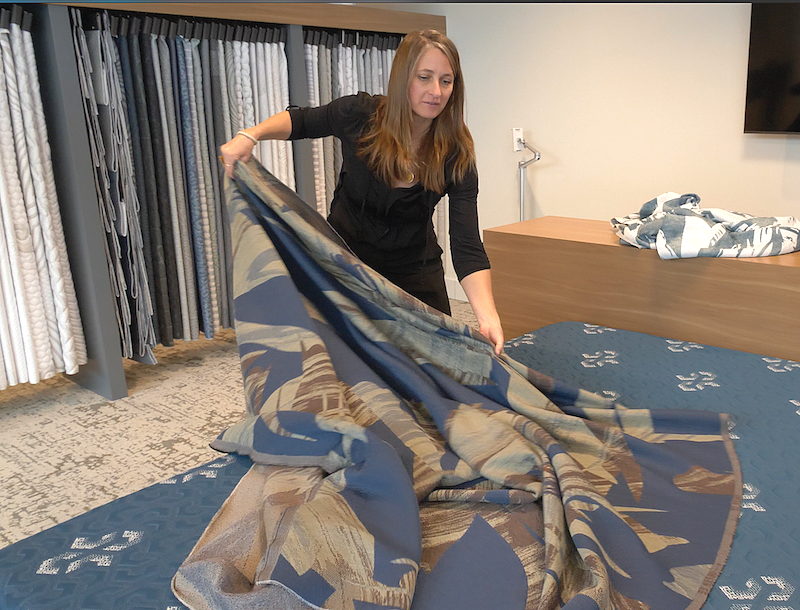

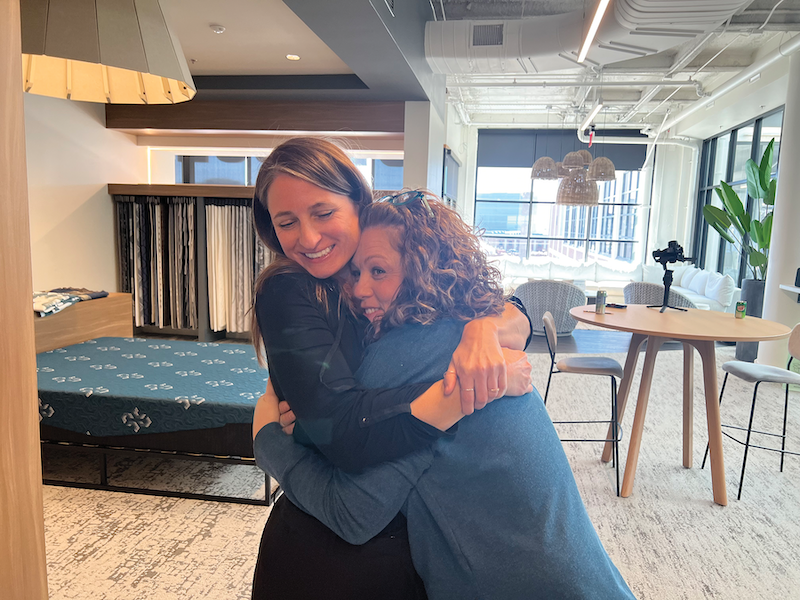
That growth and strong leadership has resonated with Culp’s customers, among them luxury bedding maker Kingsdown, headquartered in Mebane, North Carolina.
“They bring strong design at a competitive price,” says John Farnham, senior vice president of product development at Kingsdown. “And they’ve been super responsive, especially as of late. I have to give them credit, because looking at their performance with us for the last year, they’ve performed the best they have in the 15 years that I’ve worked with them. So, they’re executing right now at a very high level.”
Pennant’s can-do attitude reinforces Farnham’s sentiments: “We offer the best that we can, and there’s more to us than just making fabrics. We’re a breadth of knowledge and experience.”
Take Tara Bulla, a designer with Culp for 25 years. She knows what it takes to make a fabric shimmer.
“When we think of handwriting and inspiring, when Tara creates her works of art, she tacks colorways that create brilliant gradients,” Pennant says. “She can make fabric shimmer and have this halo effect, and it may not have one drop of lurex (metallic thread) in it.”
Greta Speer, a Culp designer for six years, adds that Bulla, like herself, leans toward performance fabric and athletic textures, with a strength in technical designing.
“Greta is also a great problem-solver,” adds Tanja Tusa, senior stylist. “When something doesn’t work out, she actually enjoys trying to find a solution.”
Tusa, a Culp designer for 11 years, says her strength is trying new things — and she is super creative, the team chimes in. “If I don’t push the envelope, then we’ll never come up with something new,” Tusa says. “But the problem with that is that there are issues, and so I will lean on Greta to help me solve them.”
Miah Bryant, assistant textile designer, is one of the newest members of the team, on board with Culp for three years. “I like fine-tuning and detail,” Bryant says.
“With Miah being newer to the industry, she’s a sponge in that she soaks up everything from the design team and our merchandising team,” Pennant says. “And I think that’s what helps create a fresh approach.”
Philip Burger, senior concept artist at Culp, blends the conceptual and the digital. “I work between being very abstract and also pushing things digital and improving that kind of presence,” Burger says.
Finally, Hunter Morton, concept designer of merchandise, brings a background in fashion and retail to his merchandising approach. “I get the privilege of organizing everything that our talented design team does,” Morton says. “So, my skill is to merchandise the product in a creative yet effective way that is aesthetically pleasing and also easy to navigate for our cross-functional sales partners.”
Another newbie to the industry, Morton also shakes things up, Pennant adds. “I would say that one of Hunter’s strengths is to look at things in a different way,” she says. “Sometimes we can be a little cookie cutter, if you will, but he will not bring the cookies to his merchandising.”
Digital advancements

Just as the designers complement each other, they also help one another navigate the industry’s challenges, such as becoming more digitally advanced (as seen in Culp’s new SoHo collection, which it describes as a line “for those who enmesh with the digital world and embrace bold choices”).
Four years ago, Culp Home Fashions began working with imagine.io (formerly Live Furnish) to create digital 3D renderings. “It allows us to take simulations of fabric and then map them on bed models,” Burger says. “You can get a better idea of what your final product is going to look like and how it pairs with different borders and what it looks like in a space. … And it’s rather user-friendly.”
Bulla chimes in, “Before, it was all done by hand, and it took hours. We’ve been doing mattress renderings and models and mock-ups for many years, but it was all by hand in Photoshop. And now this program allows our customers to interface with it.”
For Tusa, imagine.io is a creative tool. “What’s nice is you can start mixing and matching,” she says. “Before, we didn’t have actual simulations of our fabric where it was in 3D, and you couldn’t see the loft.
“Now, you can try different colors of the same fabric, and you can say, ‘Oh, what does this border look like? What if we put in a different gusset?’ So, you can build your outfit on the bed with your panel, your gusset, your border, your tapes, your foundation before investing in actually having to make it. So, it saves money, it saves time, and it expands the creativity.”
Burger points out that imagine.io also helps Culp reduce the number of fabric samples, which leads to another benefit — reducing the company’s carbon footprint because it makes and transports less fabric.
Sustainable focus
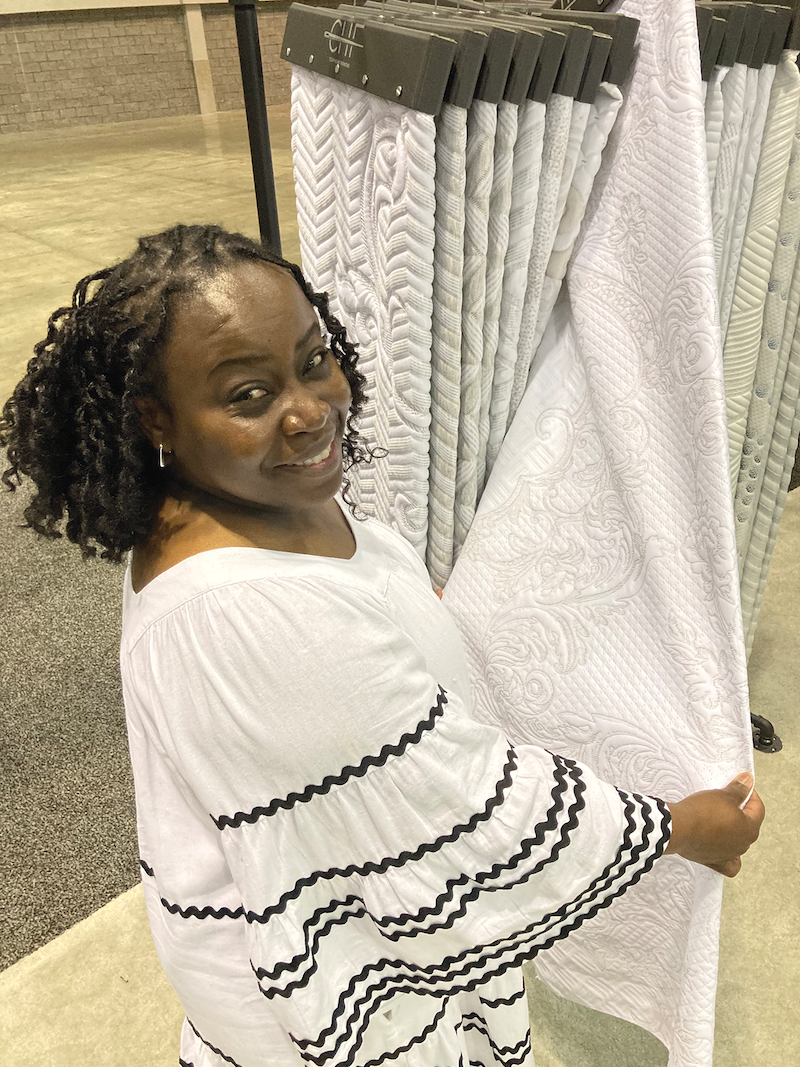
In keeping with the bedding industry’s eco-friendly stance, Culp uses sustainable yarns such as Tencel, Econyl, Repreve and Seaqual. “Repreve is one of my favorites because we use it in the inlay, so you can use it in any fabric,” Bulla says. “You don’t have to redesign or change your color SKU to fit it in.”
At ISPA EXPO in March, the company unveiled its Zero collection. The new line tells a natural story by minimizing environmental impact. Its yarns and technology focus on low impact and circularity, with designs that evoke a feeling of blending with nature.
“We used a lot of Tencel in our Zero collection because it has such a nice hand; it is a really lovely yarn with its closed loop system,” Tusa says. “I personally love it, and I also love cottons, and we do offer organic cottons.”
For Morton, sustainability involves looking at metrics and hitting a certain percentage or bottle count reduced from entering the waste stream.
“We have customers that want to have a sustainable look, but they may not be all in on a percentage per se,” Morton says. “Zero encompasses sustainability and thinking about how we can reduce that carbon footprint here at Culp, while removing ourselves from the percentages and metrics of, ‘This fabric needs to be a certain gram weight with a certain bottle count and have a certain thread in it.’”
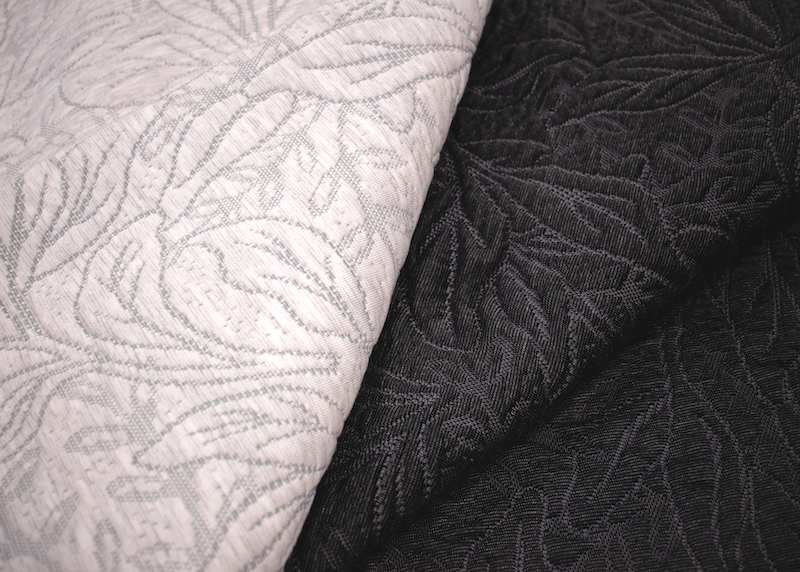

He says that some mattress companies have a tremendous organic sustainability story. “And Culp has fabrics for them, as well as anybody else that wants to enter that world of Zero or sustainability,” Morton adds. “We can meet requirements on all levels.”
In addition, the Culp Home Fashions factory is moving toward zero waste and recycles everything in the building. “We have no waste; everything has a home,” Pennant says. “If it leaves us, it will go to adult shelters for the homeless, so we just keep giving back.”
In February, the company conducted its first Spread the Warmth initiative by sewing mattress fabric remnants into blankets and donating more than 250 blankets to local charities that work with the homeless.
Brand experience and heritage
Unlike some ticking companies, Culp employs brand experience managers to help with the creative design process. “We have an extremely intimate relationship with our brand experience team,” Pennant says. “The goal of the team is to live, breathe, eat and sleep the brand.
“We have some customers that are leading brand retailers and manufacturers, and the brand experience managers work intimately with them to garner every piece of information to get from point A to point Zed and bring it to the design team.”

High Point is an inspiring place for designers during
markets, as well as a hub where they meet with clients.
Even more helpful, some brand experience managers are former designers. “They have a design language and can speak a language that we can interpret and understand,” Bulla says. “So, when they come to us with a project or descriptions, we have a better grasp of what is needed.”
Another key differentiator is Culp’s heritage, starting as R.G. Culp & Associates in 1972 making fabrics for the upholstery industry. Today, Culp is a publicly traded, international fabric company known for its fashion-driven business focusing on product innovations and new collections.
“We’ve been around for a long time,” Bulla says. “And the longevity speaks to our ability to make customers happy. We work with our customers — not make customers work with us. We try to make our products meet their needs. We try to innovate … with whatever they’re needing. We try to achieve whatever form or fashion that takes.”
Culp also encompasses other divisions, such as upholstery and cut and sew, with capabilities in wovens, covers and borders. “We can do everything vertically from making fabric to finishing the cover, with almost all the parts of the cover with our wovens,” Tusa says.
“And we’re not about being just a mattress company,” Pennant adds. “We have a lot of talent in every single corner of every building. … And I think that Culp in totality has a lot to offer.”
Bulla sums it up: “I’ve been here for 25 years, and this is my family. … We want to do beautiful things and to be original and creative. … But we’re a family. We have a greater purpose.”
Want to see more? Visit Culp Home Fashions Design Tour: Beds by Design Takes You Inside for a full-length video tour. Meet the Culp designers at Culp’s Design Team & Innovation: Meet the Clup Designers (In Their Own Words).




